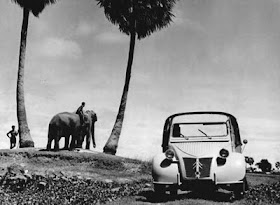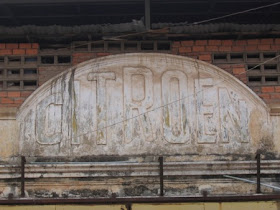

The Old Stadium, also known as the RCAF (Royal Cambodian Armed Forces) Stadium, or Stad Cha to the locals, is located just north of the Chruoy Chanva Bridge roundabout in Russei Keo district. The French embassy and former Funcinpec headquarters are just a couple of the notable structures/former structures in the area.
Its distinctive brick lighting towers can still be spotted from far away. The area around the stadium was sold off some years back, and has since been developed. The older picture isn’t quite as old as it looks. The green oil tanker gives it a 1950s look, along with the tint. However the 4WD behind it looks distinctly like a 1998 Land-cruiser, and the billboards look even more modern, so I’d guess it was taken around 2003 or so.
It was in some ways a very pretty picture, compared to the more built up look it has now, with a big development ringing the whole stadium, and all the surrounding streets built up to some extent too. Overall though, it’s still a dog-rough neighborhood, I’ve worked in it plenty of times. The whole now built-up street on the east of the stadium is taken up by auto-parts businesses. Greasy - pavements with grease-monkeys chucking oily chunks of metal about in a whole stinking carnage of sump-smoke, busted valves and burnt-out radiators. It’s a great place when you need some spares, but no place to go looking for coffee or pretty much anything else. The road used to continue north from here, and was the actual national route, but there’s no way through now north of the stadium. What used to be a thoroughfare is now a T-junction with a row of bog-standard Chinese-style shop-houses blocking the way. There isn’t really any way around it either, I’ve been through the back-lanes beyond with local and foreign friends but none of the tracks go anywhere anymore except deep into small neighborhoods, with their shop-houses striking up in the middle of all sorts of traditional houses, shacks and lean-tos. The main road now follows the river a few hundred meters to the east.
Anyway, the pictures are both taken from around the same spot, perhaps ten years apart, the differences are remarkable. You have the same bushes, light patches on the paving, and the lighting towers are still standing proud. Besides that, everything has changed, and the big mature trees in the foreground along with the parkland are now just more shop-houses.
Its distinctive brick lighting towers can still be spotted from far away. The area around the stadium was sold off some years back, and has since been developed. The older picture isn’t quite as old as it looks. The green oil tanker gives it a 1950s look, along with the tint. However the 4WD behind it looks distinctly like a 1998 Land-cruiser, and the billboards look even more modern, so I’d guess it was taken around 2003 or so.
It was in some ways a very pretty picture, compared to the more built up look it has now, with a big development ringing the whole stadium, and all the surrounding streets built up to some extent too. Overall though, it’s still a dog-rough neighborhood, I’ve worked in it plenty of times. The whole now built-up street on the east of the stadium is taken up by auto-parts businesses. Greasy - pavements with grease-monkeys chucking oily chunks of metal about in a whole stinking carnage of sump-smoke, busted valves and burnt-out radiators. It’s a great place when you need some spares, but no place to go looking for coffee or pretty much anything else. The road used to continue north from here, and was the actual national route, but there’s no way through now north of the stadium. What used to be a thoroughfare is now a T-junction with a row of bog-standard Chinese-style shop-houses blocking the way. There isn’t really any way around it either, I’ve been through the back-lanes beyond with local and foreign friends but none of the tracks go anywhere anymore except deep into small neighborhoods, with their shop-houses striking up in the middle of all sorts of traditional houses, shacks and lean-tos. The main road now follows the river a few hundred meters to the east.
Anyway, the pictures are both taken from around the same spot, perhaps ten years apart, the differences are remarkable. You have the same bushes, light patches on the paving, and the lighting towers are still standing proud. Besides that, everything has changed, and the big mature trees in the foreground along with the parkland are now just more shop-houses.











